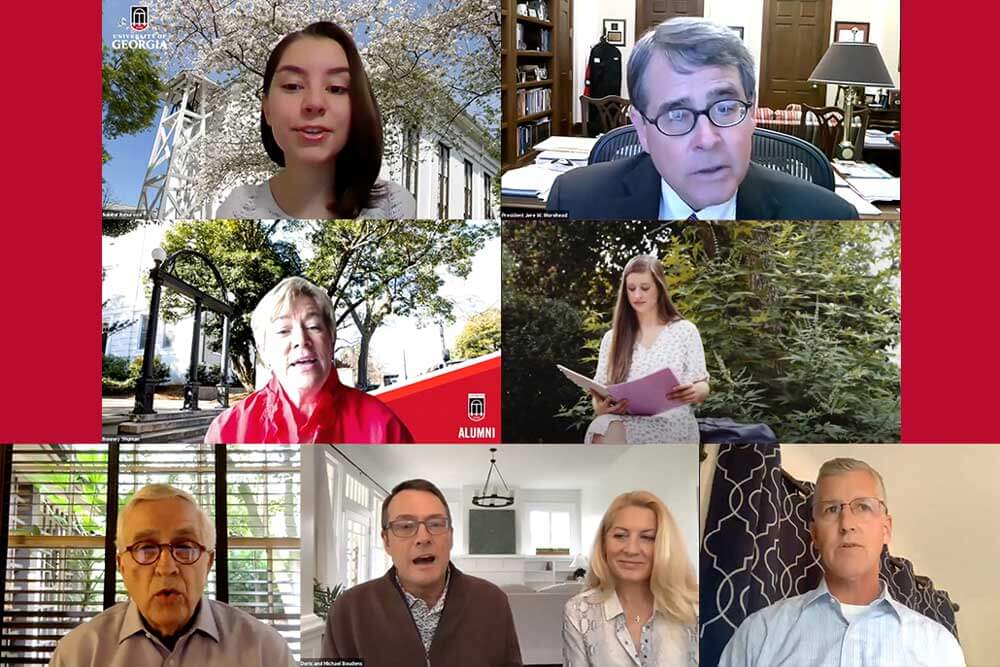Collaboration Spotlight: GCS Celebration
The Georgia Commitment Scholarship Program was a program designed for collaboration. Collaboration among central development, schools and colleges, Division of Academic Enhancement, Office of Student Financial Aid, foundations, companies, donors, supporters, students – all working together to make GCS the successful program it is today. It’s only fitting the GCS celebration event would be the same.
When we first decided to host a virtual event, I must admit I was a bit relieved. From the outside, it appeared to be much less planning and organization than an in-person lunch event. It seemed simple enough – we all log into Zoom and listen to amazing stories. Through the process, we learned hosting virtual events requires a lot of planning – maybe just as much as in person events!
We are grateful to the many units who helped bring the GCS event to fruition. Along the way, we relied on knowledge of DARIT, the skills of Client Services, the resources of the Engagement Center, the creativity of DARComm, and we even had the opportunity to learn from the Parent Giving team who had hosted a similar virtual event the week prior. The scholarship program and event were both truly a team effort.
The success of the GCS program would not have been possible without DARIT (shout-out to Marcus Jennings). Marcus provided the framework of the event. His knowledge of Zoom was invaluable, and he was always available to answer our many questions and concerns. When the day of the event came, we could remain calm knowing Marcus was there in the background helping to drive the event.
First step: compile the guest list.
As we started to work on the guest list, we quickly realized we needed the help of the Client Services team to pull the list of Georgia Commitment Scholarship donors. Client Services has been a helpful resource for all GAIL questions, and this was no different. There are unique challenges for pulling donors in GAIL for GCS, and we wouldn’t have been able to email our donors and supporters if it wasn’t for the Client Services team.
Second: send the invite.
We chose to send the invitation through ThankView in order to create the look of an envelope invitation. Because Donor Relations has done a great job of putting together resources for ThankView training, it was relatively easy to work with Client Services to tag the invitation as a communication in GAIL, even though we sent through ThankView.
Third: reminder, after reminder, after reminder.
There is so much noise today, especially as most communication has shifted to a digital format during the pandemic. We relied on several different units to help spread the word about the event. Development officers and Stewies helped forward the invitation, using it as a touchpoint to donors, and encouraged donors and supporters to join the webinar (thank you all!). As we saw our numbers gradually rise, we thought it would make sense to also partner with the Engagement Center. We collaborated to send registration reminders to all invitees that hadn’t yet registered. This was a huge success as 65% of people replied to the text message. We also partnered with DARComm to send reminder emails before the event.
When the day of the event came, we remained calm knowing Marcus was in the background helping to drive the webinar. The Georgia Commitment Scholarship Program Celebration was such a joyous occasion as we shared about the impact of the program and heard heartfelt student and donor stories.
Tips we learned from hosting a virtual webinar event:
- Consider if you want a meeting or webinar format. Give participants time to practice, regardless of the format you choose.
- Make sure you have cell phone numbers from all participants. You never know when their Internet may go down and you need to quickly text/call behind the scenes.
- Prep speakers. We would suggest meeting with speakers prior to your practice session. We met with both students and donors about talking points. We recapped in an email after we talked to them. We also recommended that speakers split their screen with notes on one side and the video on the other. This way they appeared to be looking at the camera, even if they were looking at their notes.
- Provide Zoom backgrounds to speakers, especially if students are speakers. We learned early on, after seeing one too many messy dorms rooms, some students are not as cognizant of their backgrounds. Tip: Send the speakers different backgrounds that are meaningful to them and will add to their narrative.
- For text message reminders, be sure to check that information is being built for both constituents in a household. Our text message only went to the primary contact in the household, meaning if they weren’t interested or if they were unable to attend, they might not have asked their spouse or partner if they would like to attend.
- If you decide to do follow-up emails in GAIL, be sure to mark your panelists as “attended.” They may not show up on the “participants” list in Zoom. If they are marked as “no shows,” they will receive the “sorry we missed you” email from GAIL.





